Joonhyuk Kang
Forecasting-Based Biomedical Time-series Data Synthesis for Open Data and Robust AI
Oct 06, 2025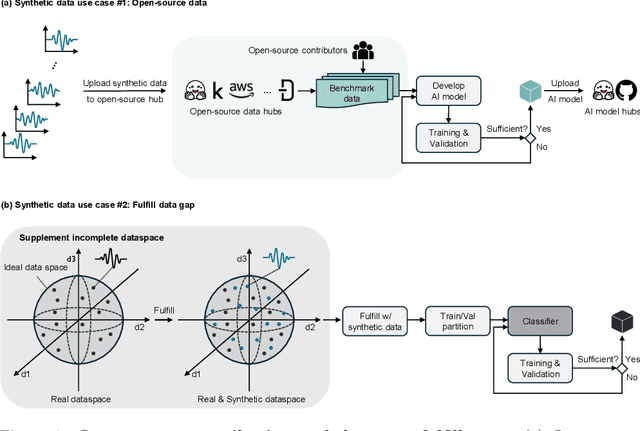
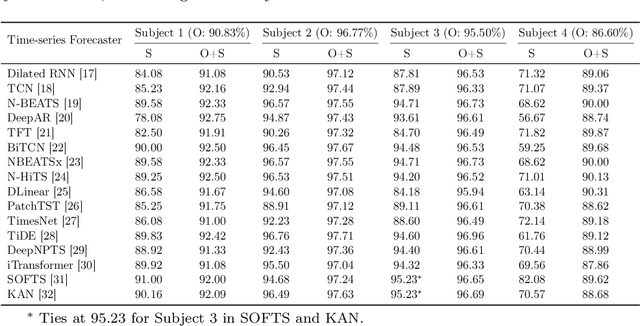

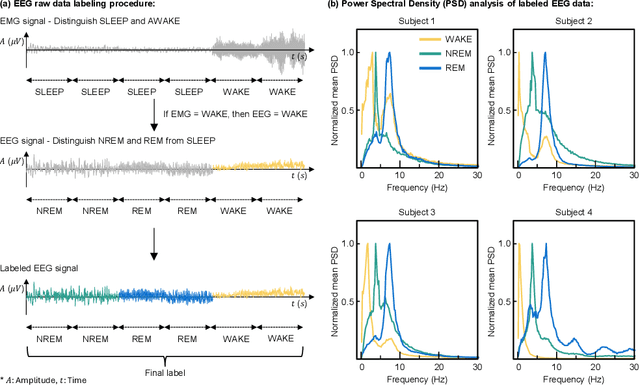
Abstract:The limited data availability due to strict privacy regulations and significant resource demands severely constrains biomedical time-series AI development, which creates a critical gap between data requirements and accessibility. Synthetic data generation presents a promising solution by producing artificial datasets that maintain the statistical properties of real biomedical time-series data without compromising patient confidentiality. We propose a framework for synthetic biomedical time-series data generation based on advanced forecasting models that accurately replicates complex electrophysiological signals such as EEG and EMG with high fidelity. These synthetic datasets preserve essential temporal and spectral properties of real data, which enables robust analysis while effectively addressing data scarcity and privacy challenges. Our evaluations across multiple subjects demonstrate that the generated synthetic data can serve as an effective substitute for real data and also significantly boost AI model performance. The approach maintains critical biomedical features while provides high scalability for various applications and integrates seamlessly into open-source repositories, substantially expanding resources for AI-driven biomedical research.
SHEFL: Resource-Aware Aggregation and Sparsification in Heterogeneous Ensemble Federated Learning
Aug 12, 2025Abstract:Federated learning enables distributed training with private data of clients, but its convergence is hindered by data and system heterogeneity in realistic communication scenarios. Most existing system heterogeneous FL schemes utilize global pruning or ensemble distillation, yet they often overlook typical constraints required for communication efficiency. Meanwhile, deep ensembles can aggregate predictions from individually trained models to improve performance, but current ensemble-based FL methods fall short in fully capturing the diversity of model predictions. In this work, we propose SHEFL, a global ensemble-based federated learning framework suited for clients with diverse computational capacities. We allocate different numbers of global models to clients based on their available resources. We further introduce a novel aggregation scheme that accounts for bias between clients with different computational capabilities. To reduce the computational burden of training deep ensembles and mitigate data bias, we dynamically adjust the resource ratio across clients - aggressively reducing the influence of underpowered clients in constrained scenarios, while increasing their weight in the opposite case. Extensive experiments demonstrate that our method effectively addresses computational heterogeneity, significantly improving both fairness and overall performance compared to existing approaches.
Energy-Efficient Secure Communications via Joint Optimization of UAV Trajectory and Movable-Antenna Array Beamforming
Jul 28, 2025Abstract:This paper investigates the potential of unmanned aerial vehicles (UAVs) equipped with movable-antenna (MA) arrays to strengthen security in wireless communication systems. We propose a novel framework that jointly optimizes the UAV trajectory and the reconfigurable beamforming of the MA array to maximize secrecy energy efficiency, while ensuring reliable communication with legitimate users. By exploiting the spatial degrees of freedom enabled by the MA array, the system can form highly directional beams and deep nulls, thereby significantly improving physical layer security. Numerical results demonstrate that the proposed approach achieves superior secrecy energy efficiency, attributed to the enhanced spatial flexibility provided by the movable antenna architecture.
Data-Efficient Prediction-Powered Calibration via Cross-Validation
Jul 27, 2025Abstract:Calibration data are necessary to formally quantify the uncertainty of the decisions produced by an existing artificial intelligence (AI) model. To overcome the common issue of scarce calibration data, a promising approach is to employ synthetic labels produced by a (generally different) predictive model. However, fine-tuning the label-generating predictor on the inference task of interest, as well as estimating the residual bias of the synthetic labels, demand additional data, potentially exacerbating the calibration data scarcity problem. This paper introduces a novel approach that efficiently utilizes limited calibration data to simultaneously fine-tune a predictor and estimate the bias of the synthetic labels. The proposed method yields prediction sets with rigorous coverage guarantees for AI-generated decisions. Experimental results on an indoor localization problem validate the effectiveness and performance gains of our solution.
RIS-assisted ISAC Systems for Industrial Revolution 6.0: Exploring the Near-field and Far-field Coexistence
Jul 10, 2025



Abstract:The Industrial Internet of Things (IIoT) has emerged as a key technology for realizing the vision of Industry 6.0, requiring the seamless integration of diverse connected devices. In particular, integrated sensing and communication (ISAC) plays a critical role in supporting real-time control and automation within IIoT systems. In this paper, we explore reconfigurable intelligent surface (RIS)-assisted ISAC systems for IIoT in the coexistence of near-field and far-field regions. The system consists of a full-duplex access point (AP), a RIS and multiple IIoT devices, where the near-field devices simultaneously perform sensing and communication, while the far-field devices rely on a RIS-assisted communication. To enhance spectral efficiency for both sensing and communication functionalities, we consider the use of both traditional sensing-only (SO) and ISAC frequency bands. Moreover, uplink non-orthogonal multiple access (NOMA) is employed to facilitate the sequential decoding of superimposed communication and sensing signals from IIoT devices. To maximize sensing accuracy in terms of Cram${\Grave{\textrm{e}}}$r-Rao bound (CRB), we formulate a joint optimization of RIS phase shift, bandwidth splitting ratio and receive beamforming vector subject to the minimum data rate requirements of IIoT devices and resource budget constraints. The algorithmic solution is developed via the successive convex approximation (SCA)-based alternating optimization (AO) method with the semi-definite relaxation (SDR) technique. Numerical results demonstrate that the proposed method significantly outperforms conventional methods relying solely on either ISAC or SO band by achieving superior performance across RIS and device configurations, while ensuring robust ISAC performance under the near-field and far-field coexistence scenarios.
Improving Generalizability of Kolmogorov-Arnold Networks via Error-Correcting Output Codes
May 09, 2025Abstract:Kolmogorov-Arnold Networks (KAN) offer universal function approximation using univariate spline compositions without nonlinear activations. In this work, we integrate Error-Correcting Output Codes (ECOC) into the KAN framework to transform multi-class classification into multiple binary tasks, improving robustness via Hamming-distance decoding. Our proposed KAN with ECOC method outperforms vanilla KAN on a challenging blood cell classification dataset, achieving higher accuracy under diverse hyperparameter settings. Ablation studies further confirm that ECOC consistently enhances performance across FastKAN and FasterKAN variants. These results demonstrate that ECOC integration significantly boosts KAN generalizability in critical healthcare AI applications. To the best of our knowledge, this is the first integration of ECOC with KAN for enhancing multi-class medical image classification performance.
A Unified Benchmark of Federated Learning with Kolmogorov-Arnold Networks for Medical Imaging
Apr 28, 2025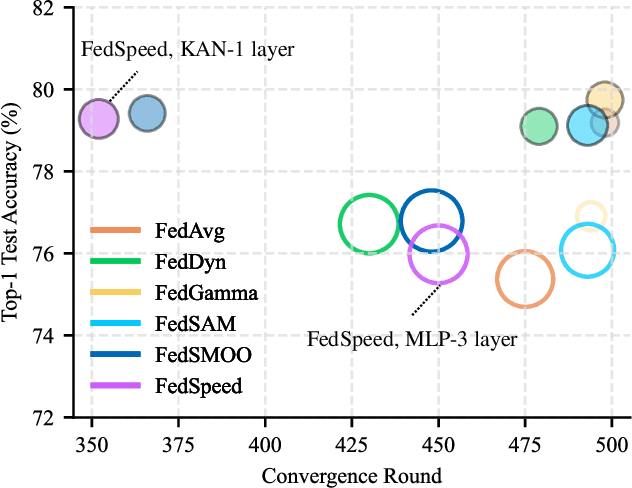
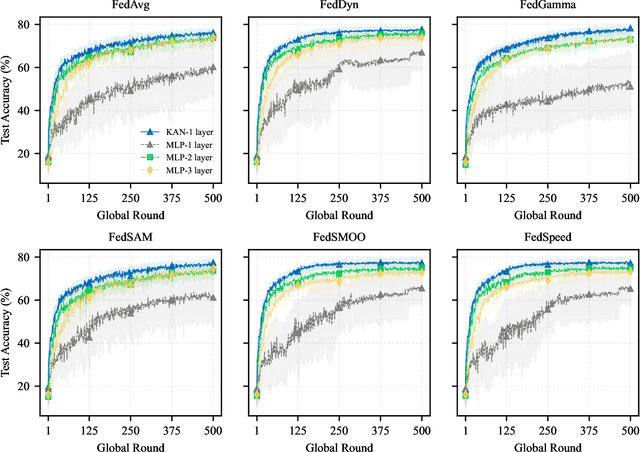
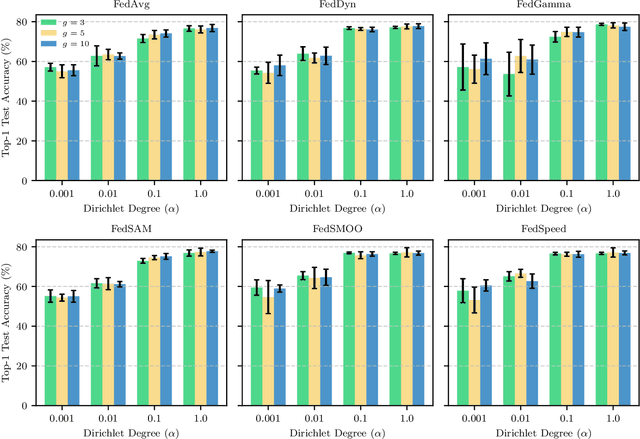
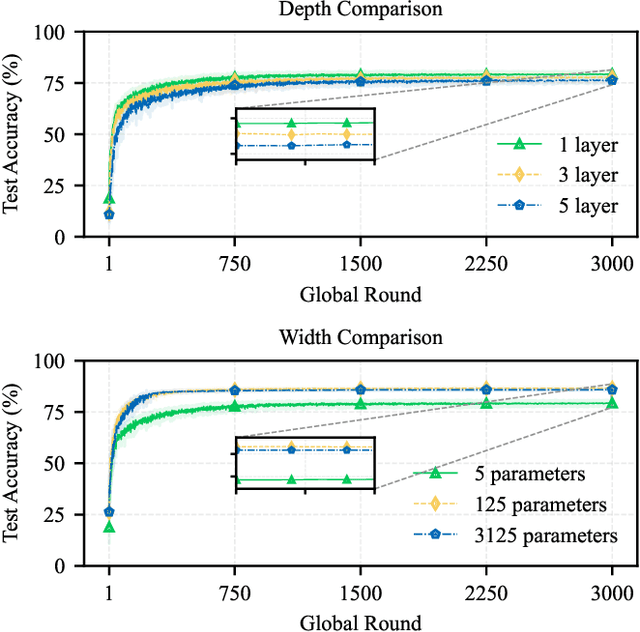
Abstract:Federated Learning (FL) enables model training across decentralized devices without sharing raw data, thereby preserving privacy in sensitive domains like healthcare. In this paper, we evaluate Kolmogorov-Arnold Networks (KAN) architectures against traditional MLP across six state-of-the-art FL algorithms on a blood cell classification dataset. Notably, our experiments demonstrate that KAN can effectively replace MLP in federated environments, achieving superior performance with simpler architectures. Furthermore, we analyze the impact of key hyperparameters-grid size and network architecture-on KAN performance under varying degrees of Non-IID data distribution. Additionally, our ablation studies reveal that optimizing KAN width while maintaining minimal depth yields the best performance in federated settings. As a result, these findings establish KAN as a promising alternative for privacy-preserving medical imaging applications in distributed healthcare. To the best of our knowledge, this is the first comprehensive benchmark of KAN in FL settings for medical imaging task.
FedEFC: Federated Learning Using Enhanced Forward Correction Against Noisy Labels
Apr 08, 2025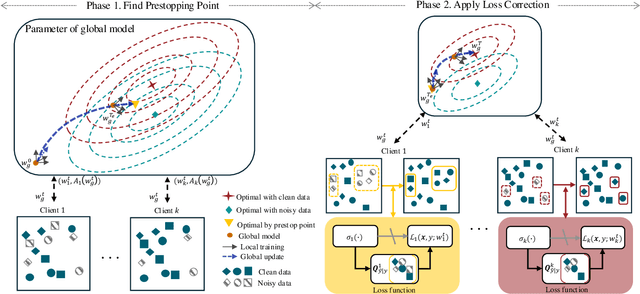

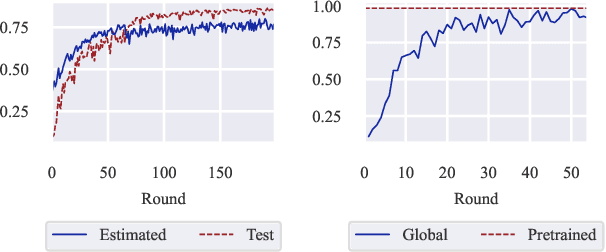

Abstract:Federated Learning (FL) is a powerful framework for privacy-preserving distributed learning. It enables multiple clients to collaboratively train a global model without sharing raw data. However, handling noisy labels in FL remains a major challenge due to heterogeneous data distributions and communication constraints, which can severely degrade model performance. To address this issue, we propose FedEFC, a novel method designed to tackle the impact of noisy labels in FL. FedEFC mitigates this issue through two key techniques: (1) prestopping, which prevents overfitting to mislabeled data by dynamically halting training at an optimal point, and (2) loss correction, which adjusts model updates to account for label noise. In particular, we develop an effective loss correction tailored to the unique challenges of FL, including data heterogeneity and decentralized training. Furthermore, we provide a theoretical analysis, leveraging the composite proper loss property, to demonstrate that the FL objective function under noisy label distributions can be aligned with the clean label distribution. Extensive experimental results validate the effectiveness of our approach, showing that it consistently outperforms existing FL techniques in mitigating the impact of noisy labels, particularly under heterogeneous data settings (e.g., achieving up to 41.64% relative performance improvement over the existing loss correction method).
Revisit the Stability of Vanilla Federated Learning Under Diverse Conditions
Feb 27, 2025Abstract:Federated Learning (FL) is a distributed machine learning paradigm enabling collaborative model training across decentralized clients while preserving data privacy. In this paper, we revisit the stability of the vanilla FedAvg algorithm under diverse conditions. Despite its conceptual simplicity, FedAvg exhibits remarkably stable performance compared to more advanced FL techniques. Our experiments assess the performance of various FL methods on blood cell and skin lesion classification tasks using Vision Transformer (ViT). Additionally, we evaluate the impact of different representative classification models and analyze sensitivity to hyperparameter variations. The results consistently demonstrate that, regardless of dataset, classification model employed, or hyperparameter settings, FedAvg maintains robust performance. Given its stability, robust performance without the need for extensive hyperparameter tuning, FedAvg is a safe and efficient choice for FL deployments in resource-constrained hospitals handling medical data. These findings underscore the enduring value of the vanilla FedAvg approach as a trusted baseline for clinical practice.
TQ-DiT: Efficient Time-Aware Quantization for Diffusion Transformers
Feb 06, 2025Abstract:Diffusion transformers (DiTs) combine transformer architectures with diffusion models. However, their computational complexity imposes significant limitations on real-time applications and sustainability of AI systems. In this study, we aim to enhance the computational efficiency through model quantization, which represents the weights and activation values with lower precision. Multi-region quantization (MRQ) is introduced to address the asymmetric distribution of network values in DiT blocks by allocating two scaling parameters to sub-regions. Additionally, time-grouping quantization (TGQ) is proposed to reduce quantization error caused by temporal variation in activations. The experimental results show that the proposed algorithm achieves performance comparable to the original full-precision model with only a 0.29 increase in FID at W8A8. Furthermore, it outperforms other baselines at W6A6, thereby confirming its suitability for low-bit quantization. These results highlight the potential of our method to enable efficient real-time generative models.
 Add to Chrome
Add to Chrome Add to Firefox
Add to Firefox Add to Edge
Add to Edge